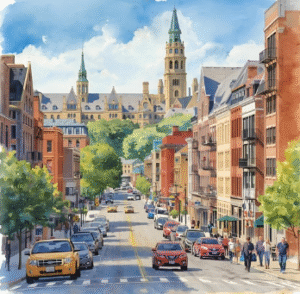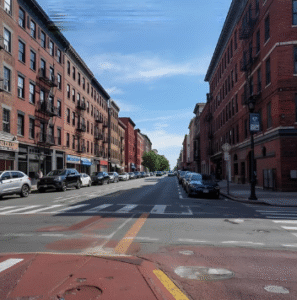Innovative Urban Planning
New Haven in 2026 introduced transformative urban planning initiatives that reshaped the city’s infrastructure and improved daily life for its residents. The focus on sustainability and accessibility was evident in the creation of interconnected networks of public spaces that encouraged outdoor activities and social interaction. These areas were designed with thoughtful layouts, incorporating native vegetation and eco-friendly materials that reduced environmental impact while promoting a healthier urban environment.
Transportation was a cornerstone of the city’s planning efforts, as New Haven rolled out efficient solutions to address the needs of a growing population. A redesigned public transit system featured electric buses and advanced scheduling technologies, enabling seamless and eco-conscious travel across the city. The emphasis on reducing car dependency led to an expanded network of bike lanes, carefully integrated into existing streets without disrupting traffic flow. Pedestrian safety also received significant attention, with upgraded crosswalks, improved lighting, and traffic-calming measures creating a more welcoming environment for walkers.
In residential areas, mixed-use zoning transformed neighborhoods by blending housing, shops, and services into cohesive, walkable communities. This approach reduced the need for long commutes while fostering local economic activity. Developments were built to include energy-efficient structures that not only conserved resources but also lowered utility costs for residents.

Technology also played a vital role in New Haven’s urban planning strategies. The city adopted data-driven systems to monitor and manage resources, such as energy usage, waste disposal, and water distribution. These smart city initiatives allowed officials to identify inefficiencies and implement real-time solutions, ensuring a higher standard of living. Green roofs and vertical gardens became a common sight, enhancing both air quality and aesthetic appeal.
Public engagement was integrated into the planning process, ensuring that residents had a voice in shaping the changes around them. Regular workshops and forums allowed community members to contribute ideas and provide feedback, which city planners used to refine their projects. This collaborative approach strengthened the bond between the local government and the people it served, creating urban spaces that reflected the community’s diverse needs and preferences.
Cultural Diversity
The cultural atmosphere in New Haven during 2026 stood out for its rich blend of traditions and creative expression. The city hosted an impressive lineup of events and festivals throughout the year, showcasing art, music, and performances from a variety of cultural backgrounds. These celebrations became a central part of the city’s identity, offering residents and visitors the chance to experience traditions from around the globe. Local artists and performers played a pivotal role in these events, highlighting the city’s commitment to nurturing creativity and diverse perspectives.
New Haven’s art scene flourished, with galleries and public installations reflecting the city’s inclusive spirit. Murals and sculptures added character to urban spaces, many of them inspired by the diverse communities that called the city home. Street art projects, often created in collaboration with residents, transformed once-ordinary spaces into vibrant reflections of local pride. Art workshops and interactive exhibits encouraged participation, making cultural appreciation a hands-on experience for people of all ages.
Food culture thrived in 2026, as New Haven solidified its reputation as a destination for culinary exploration. Restaurants, food markets, and pop-up dining experiences provided an array of choices, offering everything from traditional dishes passed down through generations to innovative fusion cuisines. Chefs from different cultural backgrounds shared their stories through food, creating opportunities for diners to connect with the heritage behind each dish. Outdoor food festivals were especially popular, bringing together local vendors and chefs to celebrate the city’s diverse flavors in a lively, communal setting.

Music and performance arts were another cornerstone of the cultural scene. From jazz and classical concerts to contemporary dance shows, the city provided a platform for both established and emerging talent. Community theaters and performance spaces welcomed collaborations between artists from different genres and backgrounds, resulting in fresh, boundary-pushing creations. Open mic nights and cultural storytelling sessions provided opportunities for personal narratives to be shared, fostering understanding and appreciation across communities.
Educational programs centered on cultural awareness also played an important role in enhancing the city’s dynamic atmosphere. Schools and community centers offered workshops and classes that delved into topics like world history, traditional crafts, and foreign languages. These initiatives not only strengthened connections among residents but also deepened their understanding of the cultural heritage that enriched daily life in New Haven.
Educational Advancements
Educational institutions in New Haven in 2026 embraced modern technologies and teaching methods to redefine learning experiences. Classrooms integrated virtual and augmented reality tools, enabling students to engage with subjects in immersive and interactive ways. These technologies allowed learners to explore complex concepts, such as anatomy or engineering design, through hands-on simulations that enhanced understanding and retention.
Collaboration between universities and local industries created unique opportunities for students to gain real-world experience. Internship programs, research partnerships, and co-op opportunities allowed young professionals to apply their knowledge in practical settings, giving them a competitive edge in their chosen fields. These partnerships also contributed to the city’s economy by ensuring a steady pipeline of skilled talent for emerging industries.
Efforts to make education more inclusive were a hallmark of the city’s strategy. Programs offering financial aid and scholarships were expanded, enabling students from all socioeconomic backgrounds to access higher education. Institutions also implemented targeted outreach initiatives to engage underrepresented communities, ensuring that talent and potential were not overlooked due to financial or social barriers.

Libraries across the city were transformed into modern learning hubs, offering not just books but also access to digital resources, maker spaces, and workshops. These spaces provided tools for coding, 3D printing, and multimedia production, encouraging creativity and innovation beyond the classroom. Local residents, regardless of age, had the chance to participate in lifelong learning opportunities, bridging the gap between formal education and personal development.
Language and cultural exchange programs were also on the rise, driven by the city’s diverse population. Schools and universities prioritized global perspectives by partnering with international institutions to offer study abroad opportunities and cross-cultural collaborations. These experiences helped students develop critical skills such as adaptability, teamwork, and communication in multicultural environments.
Teacher training and professional development programs were enhanced to support educators in meeting the demands of a rapidly changing world. Workshops focused on integrating technology into lesson plans, promoting student engagement, and addressing the diverse needs of learners. These efforts ensured that New Haven’s teachers remained at the forefront of educational best practices.
Accessible technology was a cornerstone of the city’s educational advancements. High-speed internet became available to all students, including those in underserved areas, reducing the digital divide and ensuring equal access to online resources. Schools were equipped with state-of-the-art devices, ensuring that no student was left behind in the digital age.
Furthermore, initiatives to address mental health in schools gained traction, with counselors and wellness programs integrated into academic settings. These efforts acknowledged the connection between well-being and academic success, ensuring that students had the support they needed to thrive.
Economic Growth
In 2026, New Haven’s economy thrived as new businesses and industries emerged to capitalize on the city’s forward-thinking policies and vibrant workforce. The local government provided targeted incentives, such as tax breaks and grants, to encourage innovation and attract investors. This approach not only spurred business development but also strengthened the city’s position as a hub for groundbreaking ideas and cutting-edge technologies.
Collaborative spaces, including coworking facilities and incubators, became a cornerstone of the entrepreneurial ecosystem. These environments brought together individuals from diverse professional backgrounds, fostering creativity and the exchange of ideas. Entrepreneurs benefited from mentorship programs and workshops designed to equip them with the tools and knowledge necessary to build successful ventures. Partnerships between local universities and startups also flourished, with students and researchers working side by side with business leaders to develop new products and services.
New Haven’s emphasis on sustainability was a major driver of economic activity. The city encouraged companies to adopt environmentally responsible practices and offered resources to help businesses integrate green technologies. Local manufacturers increasingly shifted to sustainable production methods, while renewable energy projects created jobs and reduced the city’s carbon footprint. These efforts attracted like-minded businesses and professionals who were eager to contribute to a forward-looking economy.
The development of creative industries also added a new dimension to New Haven’s growth. Designers, writers, and media professionals found opportunities to collaborate on projects that blended artistic expression with technological innovation. Independent creators found support through local initiatives that helped them reach wider audiences, further enriching the cultural and economic landscape.

Efforts to support small businesses played a critical role in shaping the local economy. Small-scale entrepreneurs, from family-owned shops to tech startups, benefited from access to microloans and streamlined business licensing processes. Neighborhood markets and local retail spaces allowed businesses to thrive while preserving the city’s unique character. Community members rallied around these enterprises, creating a supportive environment where residents prioritized shopping locally and reinvesting in their neighborhoods.
Infrastructure improvements further contributed to economic vitality. Upgraded public transportation and reliable high-speed internet expanded access to markets and resources, enabling businesses to operate efficiently and attract a broader customer base. These investments also made New Haven an appealing destination for remote workers and professionals seeking a city that balanced economic opportunity with an exceptional quality of life.
Additionally, workforce development programs were instrumental in equipping residents with the skills required to succeed in growing industries. Partnerships between educational institutions and businesses created training opportunities tailored to meet the demands of sectors such as technology, healthcare, and advanced manufacturing. This alignment between education and employment ensured that the local workforce remained competitive and prepared for the future.
Community Engagement
New Haven’s approach to community engagement in 2026 emphasized collaboration, inclusivity, and active participation, ensuring that residents were integral to the city’s development. By prioritizing open communication between local government and the community, the city created numerous opportunities for residents to contribute ideas, address challenges, and shape the future of their neighborhoods.
Neighborhood councils played a significant role in fostering dialogue among residents, city officials, and organizations. These councils served as a platform for identifying local needs and generating solutions tailored to specific areas. Through town hall meetings and neighborhood forums, residents were encouraged to express concerns and propose projects that directly impacted their communities. This grassroots approach not only empowered individuals but also strengthened connections between neighbors, creating a more cohesive and engaged population.
Volunteer programs were another key element of New Haven’s community engagement efforts. Residents of all ages and backgrounds participated in initiatives ranging from beautification projects to mentorship programs. Parks and community centers hosted regular cleanup events, tree-planting days, and mural-painting sessions that allowed people to take an active role in improving shared spaces. These efforts fostered a collective sense of accomplishment and pride in the city’s appearance and functionality.
Collaboration between non-profit organizations, local businesses, and government agencies further enhanced New Haven’s community initiatives. Resource-sharing networks were established to address issues like food insecurity, housing access, and youth development. For example, food distribution programs connected local farms with residents in need, while housing assistance programs worked to create pathways to affordable living for families facing financial challenges.

Youth engagement was a particular focus, with programs designed to involve younger generations in civic activities. Schools and youth organizations offered leadership opportunities that taught students about governance, environmental stewardship, and the importance of community service. Internship opportunities with city departments provided hands-on experience in addressing urban challenges, ensuring that future leaders were prepared to contribute meaningfully to their community.
New Haven also embraced digital tools to enhance participation and keep residents informed. A user-friendly city app allowed individuals to report issues like potholes or broken streetlights, access event information, and participate in surveys that shaped city policies. Social media platforms and online town halls further expanded access to engagement opportunities, reaching residents who might not have been able to participate in person.
The city also celebrated achievements through community events that highlighted the positive impact of collaboration. Festivals, parades, and award ceremonies showcased successful projects and recognized individuals who made significant contributions to their neighborhoods. These celebrations not only fostered a sense of unity but also inspired others to get involved.
By creating a culture of active involvement and mutual respect, New Haven demonstrated that a thriving city begins with the collective efforts of its people.
